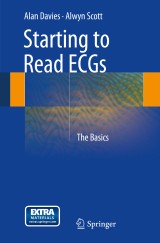Details

Starting to Read ECGs
The Basics|
53,49 € |
|
| Verlag: | Springer |
| Format: | |
| Veröffentl.: | 26.11.2013 |
| ISBN/EAN: | 9781447149620 |
| Sprache: | englisch |
| Anzahl Seiten: | 166 |
Dieses eBook enthält ein Wasserzeichen.
Beschreibungen
<p>This book is book aims to provide the beginner with a concise, practical and systematic guide to interpreting ECGs. It will serve not only as a starter text but also as an immediate bedside reference manual. <i>Starting to Read ECGs: The Basics</i> begins with fundamentals such as how to perform, record and interpret a normal ECG before progressing onto more complex topics, including what effects anatomical abnormalities of the heart, cardiac and non-cardiac conditions can have on the ECG. Each chapter has been supplemented with a multitude of images and diagrams to illustrate points and ease understanding, and concludes with both a summary of key points to reinforce knowledge and a quiz for reflective learning.</p><p><i>Starting to Read ECGs: The Basics</i> is an updated version of that previously published by CriticAir and an essential resource for medical students, junior doctors, nurses, paramedics and other health care professionals involved in the recording and interpretation of ECGs who wish to build their knowledge and confidence.</p>
<p>Chapter 1: How to record a 12-lead ECG.- Physiology.- What is an ECG.- Patient positioning.- Electrode placement.- Attaching the cables.- The machine.- What to write on the ECG.- Summary of key points.- Quiz.- Chapter 2: ECG basics.- How does the 12-lead ECG work?.- ECG paper.- Details found on a standard 12-lead ECG.- 12-lead ECG leads.- The PQRST waveform.- Deflection.- Summary of key points.- Quiz.- Chapter 3: Quality issues pertaining to ECG recording.- Background.- Leads.- Calibration markers.- ECG Documentation.- Summary of key points.- Quiz.- Chapter 4: Principles of ECG analysis.- Background.- Basic quality control checks.- The rate.- The rhythm.- The P wave.- The PR interval.- The QRS complex.- The ST segment.- The T wave.- The QT interval.- Electrical axis.- Additional features.- The normal ECG and normal variants.- Summary of key points.- Quiz.- Chapter 5: Chamber abnormalities.- Physiology.- Atrial abnormality.- Ventricular abnormality.- Normal variants.- Summary of key points.- Quiz.- Chapter 6: Arrhythmias.- Background.- Ectopic beats.- Atrial arrhythmias.- Junctional arrhythmias.- Ventricular Arrhythmias.- Summary of key points.- Quiz.- Chapter 7: Conduction delay.- Background.- Bundle Branch Blocks.- Atrioventricular Blocks (AV Blocks).- Sinoatrial blocks (SA blocks).- Sick Sinus Syndrome (SSS).- Summary of key points.- Quiz.- Chapter 8: Miscellaneous cardiac conditions.- Background.- Paced rhythms.- Types of permanent pacemaker (PPM).- ECG identification of Pacemakers.- Pericarditis.- Long QT syndromes.- Summary of key points.- Quiz.- Chapter 9: Non cardiac conditions identifiable on the ECG.- Background.- Electrolyte imbalances.- Hypothermia.- Digoxin use.- Pulmonary Embolism (PE).- Summary of key points.- Quiz.- Chapter 10: Acute Coronary Syndromes.- Background.- Atherosclerosis.- Modifiable and non-modifiable risk factors for CHD.- Angina.- Acute Coronary Syndromes (ACS).- Evolution of STEMI.- Left Bundle Branch Block (LBBB) and chest pain.- Summary of key points.- Quiz. </p>
<p>Alan Davies<br>Alan Davies graduated Birmingham City University with a 1st class honours degree; he also won a 1st place prize for adult nursing student in the inaugural Health Care Awards. At the time of writing this book Alan Davies was working as a nurse in the cardiac catheterisation labs at the Royal Devon and Exeter Hospital. Alan has experience dealing with routine and emergency angiograms including primary PCI. Alan has also assisted in pacemaker/AICD insertion, Transoesopheageal Echo (TOE), cardioversion and electrophysiological studies. He has also authored three articles, two concerning ECG’s and one about permanent pacemakers, which were published in the British Journal of Nursing and the British Journal of Cardiac Nursing respectively. Alan also has a post graduate degree module in ECGs and arrhythmias.</p><p>Alwyn Scott<br>Alwyn Scott graduated from Birmingham University and has worked in the NHS since 1995. He is currently employed as Senior Staff Nurse for the Cardiology High Dependency Department at Papworth Hospital in Cambridgeshire. His role is predominantly that of working with patients who are in the acute stages of having Heart Attacks both pre and post Primary PCI. Alwyn is also heavily involved in staff education. Alongside specialist knowledge in acute cardiac nursing and ECG interpretation, Alwyn also has a vast experience in emergency care, working in Accident and Emergency departments and also front line for the ambulance service responding to 999 calls.<br></p>
<p>This book aims to provide the beginner with a concise, practical and systematic guide to interpreting ECGs. It will serve not only as a starter text but also as an immediate bedside reference manual. <i>Starting to Read ECGs: The Basics</i> begins with fundamentals such as how to perform, record and interpret a normal ECG before progressing onto more complex topics, including what effects anatomical abnormalities of the heart, cardiac and non-cardiac conditions can have on the ECG. Each chapter has been supplemented with a multitude of images and diagrams to illustrate points and ease understanding, and concludes with both a summary of key points to reinforce knowledge and a quiz for reflective learning. </p><p><i>Starting to Read ECGs: The Basics</i> is an updated version of that previously published by CriticAir and an essential resource for medical students, junior doctors, nurses, paramedics and other health care professionals involved in the recording and interpretation of ECGs who wish to build their knowledge and confidence.<br></p>
<p>An accessible text for beginners</p><p>Concise text supplemented with a multitude of images and diagrams to explain complex ideas simply</p><p>Each chapter contains practice questions and a summary of key points to consolidate the readers knowledge</p>
Diese Produkte könnten Sie auch interessieren:

Razum prestupnika i logika prestupleniya. O psihiatrii, sudah i seriynyh ubiytsah

von: Shohom Das, Dmitry Chepusov

6,99 €

Samoe glavnoe o zhenskom zdorove. Voprosy nizhe poyasa

von: Elizaveta Grebeshkova, Olga Sedova

9,99 €

The Use of Albumin in Liver Cirrhosis - Current Treatment Concepts and Future Outlook

von: Jonel Trebicka

4,95 €













